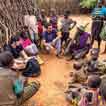A Small Shift with Potential Significant Impact: Viewing Peoples Globally

Traditional People Group Data Structure
It was in the 1960s and 1970s that Christian researchers began in earnest to identify the people groups of the world. When the original lists were made, there was limited communication and very little movement of peoples. At that time, an international flight may have cost 10 times what it does currently and taken much longer. An international telephone call typically cost several dollars per minute. The common way to stay in touch with people in other countries was often by hand- written postal letter.
Geographic distance was a significant barrier to the spread of the gospel. Diaspora groups had minimal contact with homeland populations; the homeland and diaspora peoples of the same ethnicity were considered distinct entities. People group populations were structured accordingly, and people groups were defined by including country boundaries as shown in Figure 1 below. That data structure has served the mission community well for the last 50 years. Figure 2 illustrates the traditional people group data structure and counts as presented on the Joshua Project website.

A Different World
However, the world is a very different place than when people group lists began. Travel is relatively inexpensive and rapid... we have virtually free and instant video connection... money can be sent with a few taps on a phone... family or associates can Facetime or Zoom anytime... business or ministry can be conducted remotely from another continent.
Globalization means anyone can essentially contact anyone, anywhere, anytime. The geographic barriers and “distance” between the homeland and the diaspora have significantly blurred. Migration means people are on the move with unimagined mobility. New people-groups- in-countries (PGICs) are formed whenever a homeland group moves to a new country. All this raises challenges and concerns related to the current people group terminology, data structures and presentation.

Challenges and Concerns
1. Multiple meanings of “people group”—Both entities in the dotted box in Figure 1. are currently called “people groups”. Sometimes the term “people group” means geopolitical boundaries are not considered, e.g., the Kurmanji Kurd everywhere in the world. Other times “people group” means country borders are considered, e.g., the Kurmanji Kurds in Turkey, the Kurmanji Kurds in Iraq, etc. Without context, it is unclear whether the reference is to a people-group-across-countries (PGAC) or a people-group-in-country (PGIC). This has caused substantial confusion.
2. Ever expanding list of “people groups”—The widely recognized count of “people groups” is the number of people-groups-in-country (PGICs) in Figure 1. However, the number of PGICs is essentially unlimited. Therefore, the traditional PGIC way of counting “people groups” is a continually increasing number. In turn, this causes the number of Unreached People Groups to appear to be growing. Again, confusion has resulted.
3. PGICs are weighted the same—The largest homeland groups and the smallest diaspora groups are considered at the same level when viewed at a PGIC level. They have equal weight as database entries. Each is considered a unique “people group.” For example, the nine million homeland Kurmanji Kurds in Turkey are counted the same as a few thousand diaspora Kurmanji Kurds in Norway.
4. Mixes geography into the hierarchy—Traditional geographic barriers to the spread of the gospel are diminishing. Fifty years ago, geography was considered in the hierarchy of people groups, but this may have contributed to "silos” of ministry focus at the country level and may be less helpful in today’s world.

Data modeling suggests the elements in a hierarchy ought to all be of the same “stuff”. Separating geography from the people group hierarchy may be helpful. Figure 3 shows a slightly modified people group data structure.
-
Only PGACs are called “people groups”.
-
All PGICs are no longer called “people groups” but
rather “people group in country”.
-
The count of PGACs becomes the emphasized number.
-
PGICs are not part of the hierarchy but are still fully available.
Fortunately, people group data is currently coded such that Figure 3 is already available. PGACs already have a unique identifier, and the data presently can be viewed by PGAC. The change would mainly be in the presentation of the data and which count is emphasized as “the number of people groups in the world”. Using the Joshua Project numbers from Figure 2, there would be 10,422 people groups and 17,433 people groups in country.
Potential Benefits and Opportunities
The perspective change in Figure 3 is relatively small, but addresses the four concerns above:
- Has the benefit of different names for PGACs “people groups” and PGICs “people groups in country”.
- The count of PGACs is a reasonably stable number. The goalposts are not continually moving. Also, there is likely a much higher degree of agreement between various people group lists at the PGAC level.
- Allows users to differentiate between homeland and diaspora people groups in country, in any way desired. Considering an ethnicity as a global whole might help foster strategy and best practices across the entire PGAC.
- Removes geography from the hierarchy but keeps PGIC counts available. The PGIC people-group-in-country perspective probably will continue to be the initial way users approach people group data as most users start from a country mindset. This modified structure also allows for further refining to people-group-in-states/ provinces without adding to the hierarchy and further disrupting terminology and counts.
Recommendations
- A. Present a biblical basis for the PGAC “people group” perspective. Current geo-political boundaries did not exist when Jesus gave the Great Commission.
- B. Begin highlighting and emphasizing the PGAC perspective. Show the PGIC and PGAC total and unreached counts side-by-side. Compare and explain the counts: Why two sets of numbers? What do they mean? How do they compare to the past?
- C. Encourage other people group list keepers, mobilizers and stakeholders to begin using the revised terminology and numbers.









comments